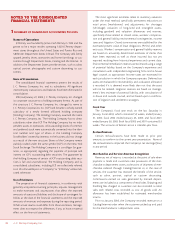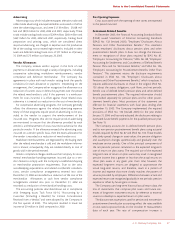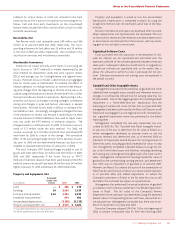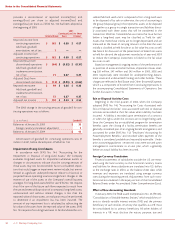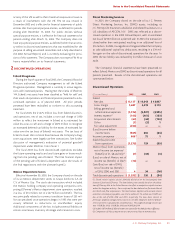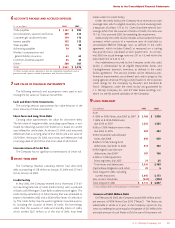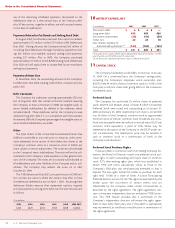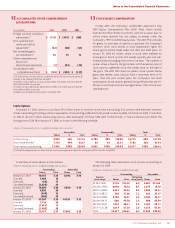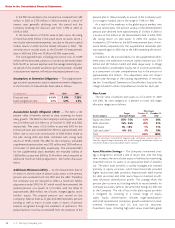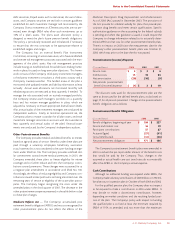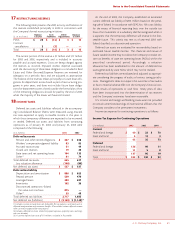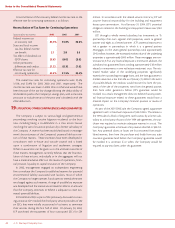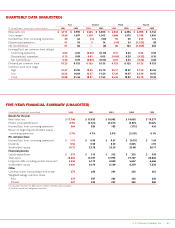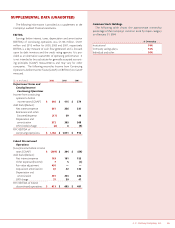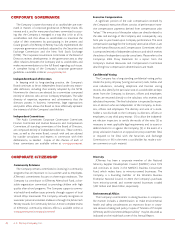JCPenney 2003 Annual Report Download - page 38
Download and view the complete annual report
Please find page 38 of the 2003 JCPenney annual report below. You can navigate through the pages in the report by either clicking on the pages listed below, or by using the keyword search tool below to find specific information within the annual report.
J. C. Penney Company, Inc.36
Notes to the Consolidated Financial Statements
The Company follows the intrinsic value expense recognition
provisions of APB 25 as permitted by SFAS No. 123. As a result,
no compensation expense is recognized for stock options. As
required by SFAS No. 123, the Company estimates the pro forma
effect of recording the estimated Black-Scholes fair value of stock
options as expense over the vesting period. See Note 1.
Stock Awards
The Company awarded approximately 364,000, 227,000 and
133,000 shares of stock to employees with weighted-average grant-
date fair values per share of $19.43, $20.09 and $15.94, respectively,
in 2003, 2002 and 2001, respectively. Total expense recorded for
stock-based employee compensation awards was $8.2 million, $5.1
million and $7.5 million in 2003, 2002 and 2001, respectively.
The 2001 Plan also provides for grants of restricted stock awards
and stock options to outside members of the Board of Directors.
Restricted stock awards acquired by such directors are not trans-
ferable until a director terminates service. The Company granted
shares of common stock totaling 36,682, 21,266 and 18,608 to out-
side members of the Board of Directors in 2003, 2002 and 2001,
respectively. Total expense recorded for these directors’ awards
was $0.7 million, $0.5 million and $0.4 million in 2003, 2002 and
2001, respectively.
14 LEASES
The Company conducts the major part of its operations from
leased premises that include retail stores, Catalog/Internet fulfill-
ment centers, warehouses, offices and other facilities. Almost all
leases will expire during the next 20 years; however, most leases
will be renewed or replaced by leases on other premises. Rent
expense for real property operating leases totaled $231 million in
2003, $252 million in 2002 and $266 million in 2001, including
contingent rent, based on sales, of $23 million, $24 million and
$24 million for the three years, respectively.
JCPenney also leases data processing equipment and other
personal property under operating leases of primarily three to
five years. Rent expense for personal property leases was $80 mil-
lion in 2003, $85 million in 2002 and $74 million in 2001.
As of January 31, 2004, future minimum lease payments for
non-cancelable operating and capital leases were:
($ in millions) Operating Capital
2004 $213 $ 5
2005 186 5
2006 145 5
2007 112 5
2008 99 3
Thereafter 415 —
Tot al minimum lease payments $1,170 $ 23
Present value $657 $ 20
Weighted average interest rate 9.2% 5.9%
In December 2003, JCP notified the third party service
providers of the six outsourced SSCs of its intent to terminate
their services during the first half of 2004. In accordance with the
related service contracts, JCP will assume financial responsibility
for the building and equipment leases upon termination. The
future minimum lease payments under the current third-party
agreements for 2004, 2005, 2006, 2007, 2008 and after five years
are $16 million, $17 million, $22 million, $11 million, $11 million
and $43 million, respectively.
15 RETIREMENT BENEFIT PLANS
The Company provides retirement and other postretirement
benefits to substantially all employees (associates), except for
associates hired or rehired on or after January 1, 2002, who are
not eligible for retiree medical or dental coverage. These benefits
are an important part of the Company’s total compensation and
benefits program designed to attract and retain qualified and tal-
ented associates. The Company’s retirement benefit plans consist
of a non-contributory qualified pension plan (primary pension
plan), non-contributory supplemental retirement and deferred
compensation plans for certain management associates, a 1997
voluntary early retirement program, a contributory medical and
dental plan, and a 401(k) and employee stock ownership plan.
Tot al Com pany expense for all retirement-related benefit plans
was $207 million, $106 million and $33 million in 2003, 2002 and
2001, respectively. These plans are described in more detail below.
See Management’s Discussion and Analysis under Critical
Accounting Policies on pages 9-10 for additional discussion of
the Company’s defined benefit pension plan and Note 1 on
pages 27-28 for the Company’s accounting policies regarding
retirement-related benefits.
Defined Benefit Retirement Plans
Primary Pension Plan — Funded
The Company and certain of its subsidiaries provide a non-
contributory pension plan to associates who have completed at
least 1,000 hours of service generally in a 12 consecutive month
period and have attained age 21. The plan is funded by Company
contributions to a trust fund, which is held for the sole benefit of
participants and beneficiaries. Participants generally become
100% vested in the plan after five years of employment or at age
65. Pension benefits are calculated based on an associate’s aver-
age final pay, an average of the social security wage base, and the
associate’s credited service (up to 35 years), as defined in the plan
document.
Estimated Future Benefit Payments
($ in millions) Pension Benefits(1)
2004 $196
2005 204
2006 213
2007 222
2008 233
2009-2013 1,327
(1) Does not include plan expenses.
Supplemental Retirement Plans — Unfunded
The Company has unfunded supplemental retirement plans,
which provide retirement benefits to certain management asso-
ciates and other key employees. The Company pays ongoing
benefits from operating cash flow and cash investments. The pri-
mary plans are a Supplemental Retirement Plan, a Benefit
Restoration Plan and a Voluntary Early Retirement Plan. Benefits
for the Supplemental Retirement Plan and Benefits Restoration
Plan are based on length of service and final average compensa-
tion. The Benefit Restoration Plan is intended to make up bene-
fits that could not be paid by the qualified pension plan due to
governmental limits on the amount of benefits and the level of


